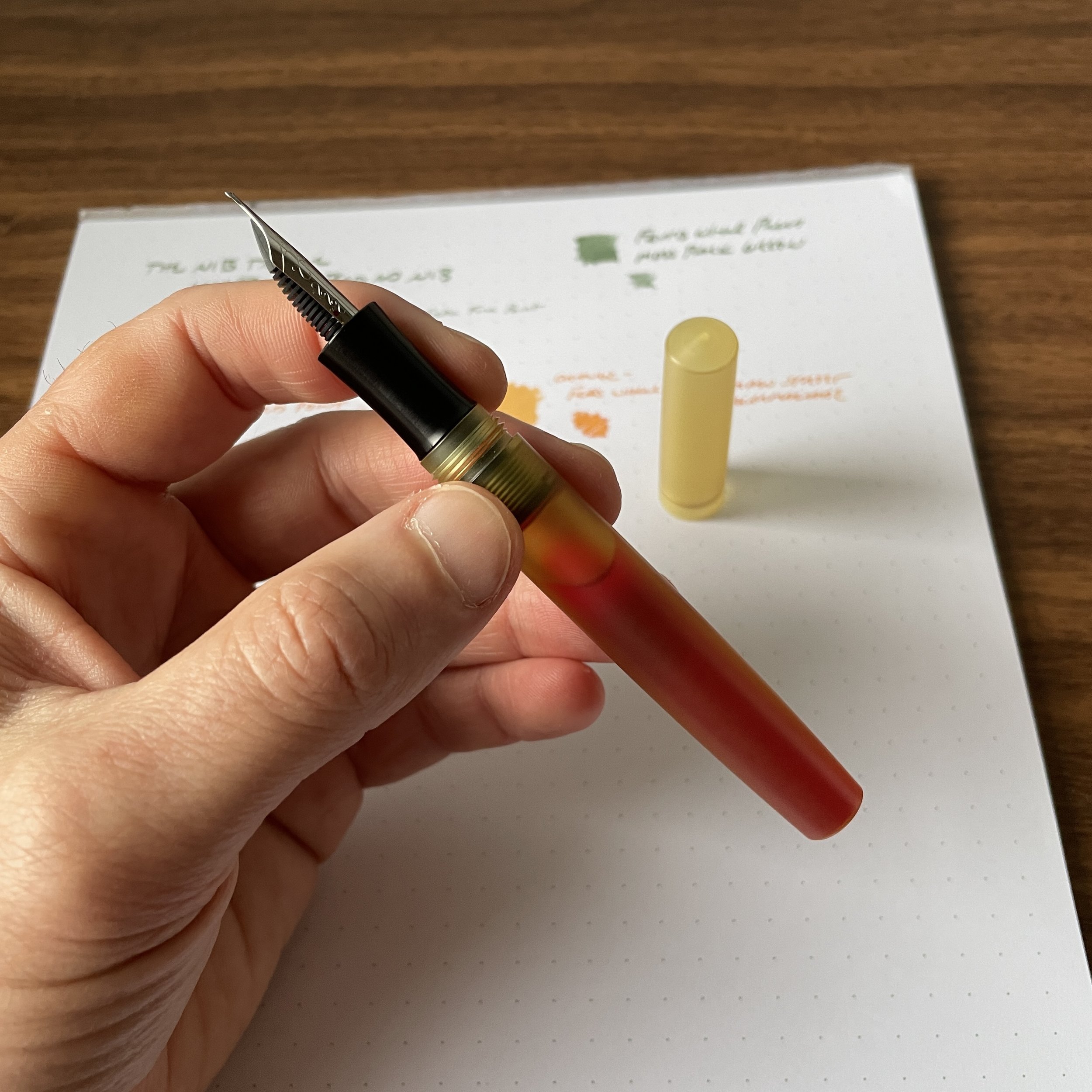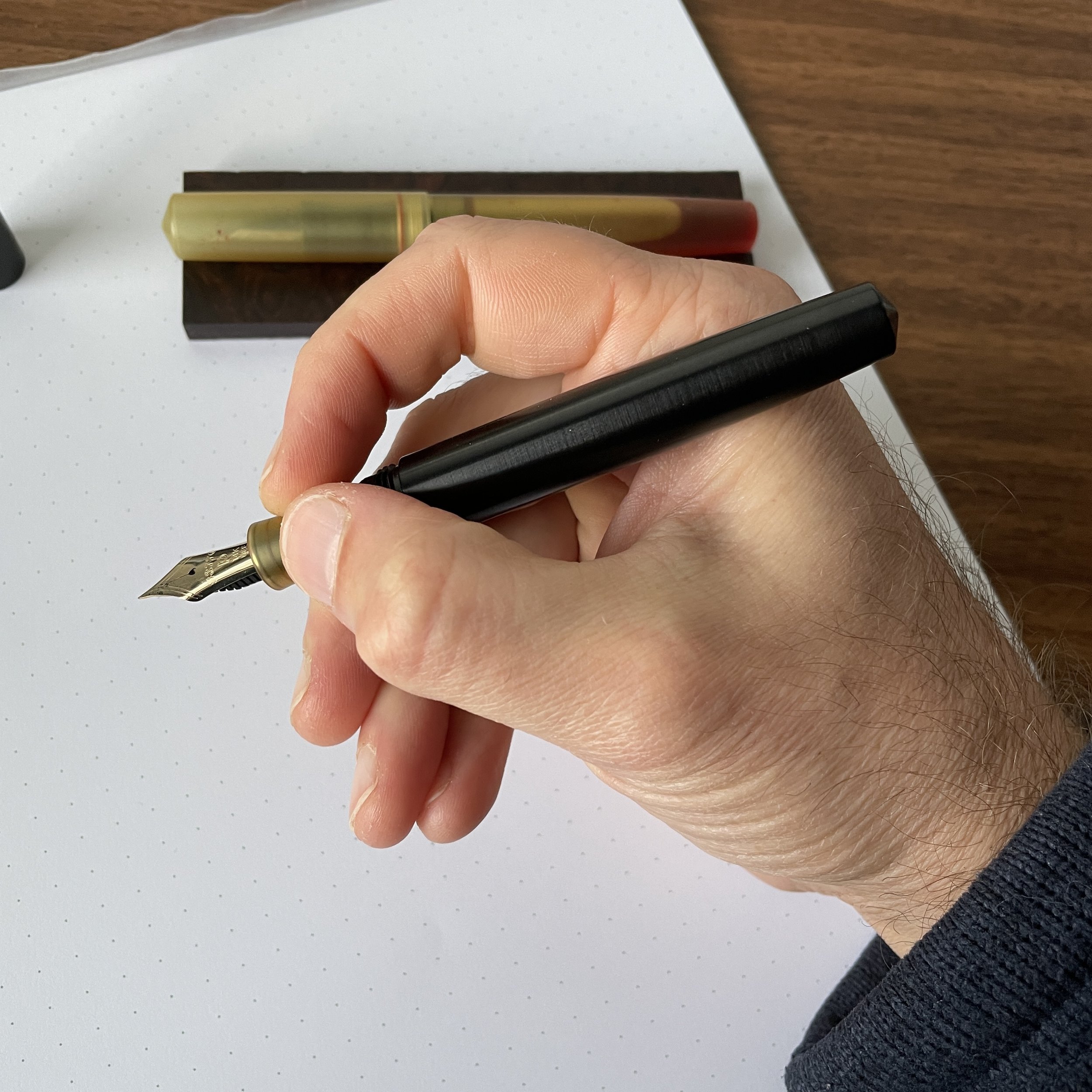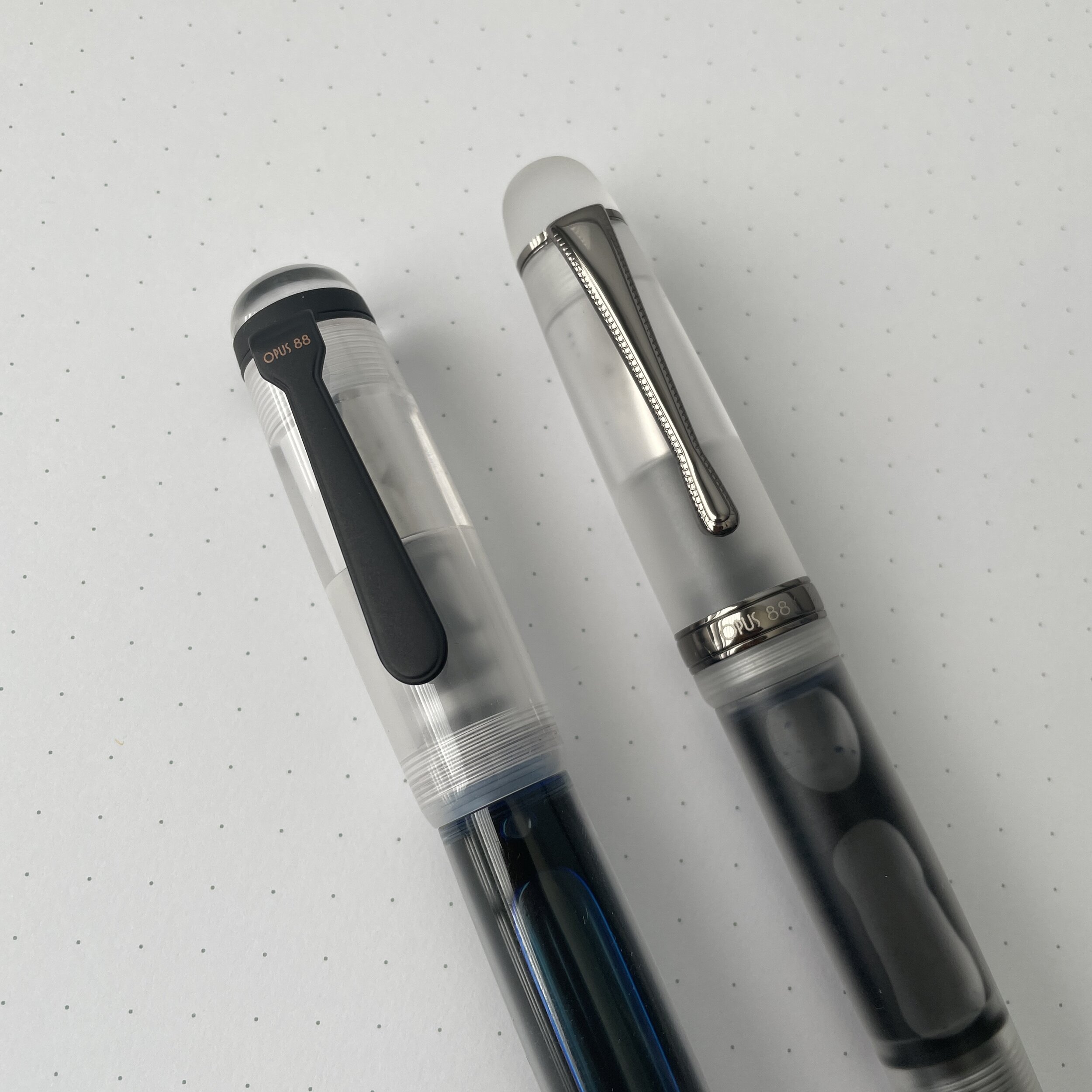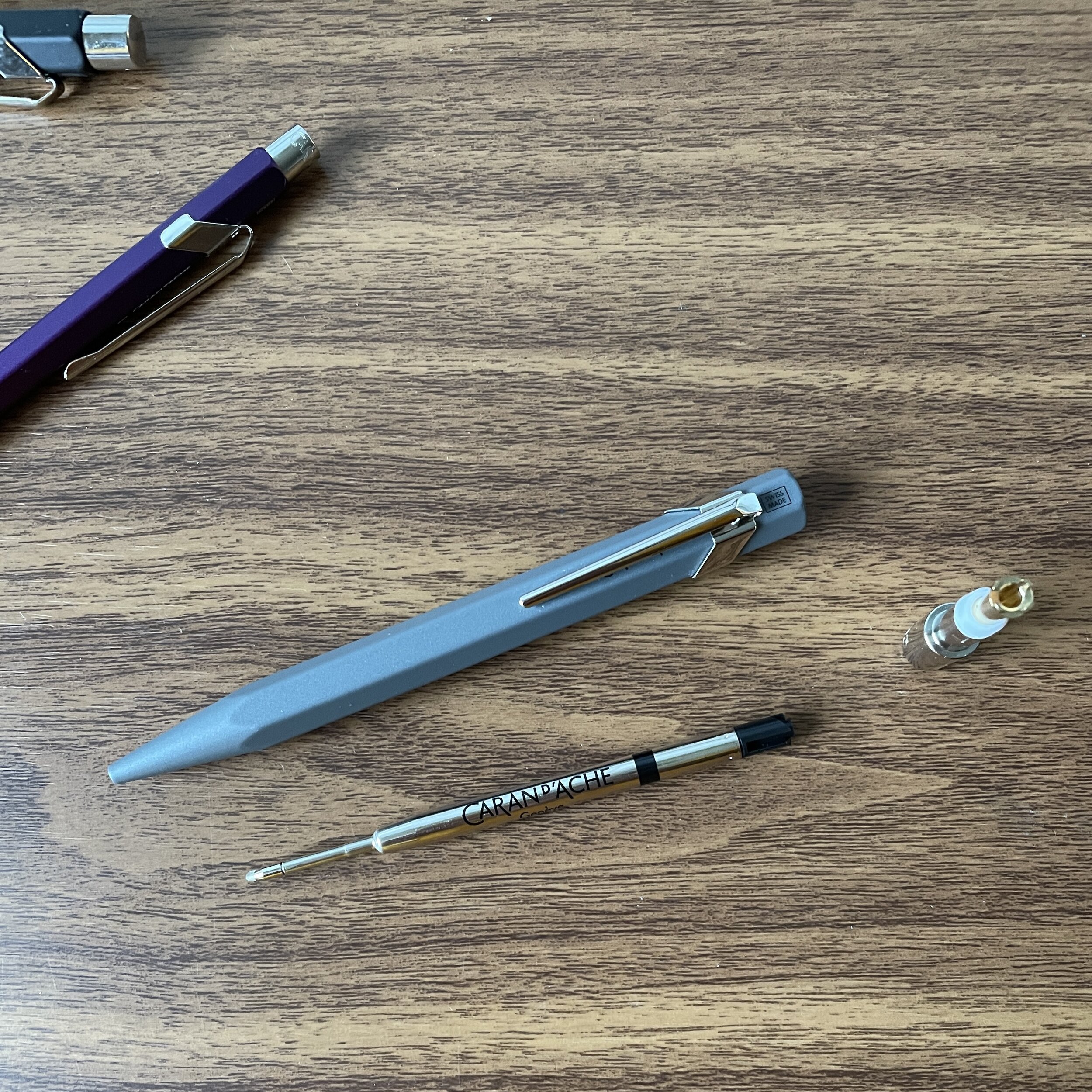By far my biggest prizes from this year’s pen show season have been my two newest additions from Schon DSGN: Ian’s first full-size fountain pens made from the engineered plastic Ultem. This material is increasingly popular in penmaking, so you may have seen a bunch of pictures of Ultem pens in recent month, both from Schon DSGN and other makers, and wondered, what the heck is it?
Ultem is a “semi-transparent high-strength plastic” that is capable of being machined thinner than most other plastics or acrylics, so when used in penmaking you get a pen that is not only resistant to cracking and breaks from accidental drops, but chemical and stain resistant as well. (Source: Curbell Plastics). You read that last part right: If you’ve been dreaming of eyedroppering that transparent fountain pen with Noodler’s Baystate Blue, you can fill your Schon DSGN Ultem pen with Baystate or any other high-maintenance ink with a clean conscience, since it will neither stain nor disintegrate! This makes sense once you understand that in “real life”, Ultem is so durable that it is typically used to make medical, industrial, and other scientific equipment.
I swapped the sections on my two Schon DSGN fountain pens as soon as I got them. It looks great and adds just enough variation to make them interesting without looking overly mismatched.
I admit that I was a touch skeptical when these pens were first released, not because I doubted that Ian Schon would make a great full-size fountain pen, but rather because I didn’t understand how the properties of Ultem justified the somewhat hefty price tag. Ultem as a material isn’t cheap, so a cartridge-converter Ultem fountain pen with a steel nib starts at $250. But as with most things Schon DSGN, once you get the product itself in your hands, you realize that you get what you pay for. Here’s a short list of what I love about the Schon DSGN Ultem fountain pen:
Lightweight Design. Ultem’s key selling point - its extremely light weight - translates well to pen design. For example, you can post the cap on the end of the pen with no perceptible change in weight or balance. I’ve never had an experience like this posting a fountain pen before. To me, it’s the epitome of well-considered and creative pen design: using the properties of a specific material in a way that actually enhances the user experience.
Eyedropper Capability. I generally don’t eyedropper standard cartridge-converter fountain pens, as they tend to burp ink into the cap (and eventually, onto your hand) due to air pressure and temperature shifts. Unless you use a Japanese-style system that includes a “shutoff valve,” or skillfully apply o-rings and silicone grease to minimize potential leakage, you could end up with a real mess on your hands. Here, Schon DSGN has already included at least five o-rings into the design of the Ultem fountain pen (I count four in the section and one in the cap), making it eyedropper-ready. I’ve flown with these pens twice and have had no serious “ink-cidents.”
Comfort. The Ultem fountain pen is designed for comfort. Not only is it lightweight, but the concave section provides a nice grip, and the threads are high enough on the barrel to stay out of the way. Ultem as a material has a nice grippy texture that doesn’t get slick over the course of longer writing sessions.
Durability. I’ve carried this pen in a traditional pen case, loose in a bag, and in my pocket, and have had no issues with scratches, cracks, or other damage. Given the industrial uses for Ultem, it’s highly unlikely that the average fountain pen user could stress this pen to the degree necessary to cause damage. While not marketed as a “pocket pen,” I would carry the Schon Ultem in my pocket with confidence.
Nib Versatility. Designed to take a JoWo No. 6 nib unit, this opens the door to all sorts of customization, as I discussed in a separate article a couple of weeks ago. Currently, I have an “inverted architect” nib in my amber Ultem fountain pen, and a Platinum UEF nib in my Black Ultem (courtesy of specialty housings available from Flexible Nib Factory). Another fun fact: the parts and sections on the Schon Ultem pens are interchangeable, meaning that you can swap the amber section and/or cap onto the black pen, or vice-versa. Ian also sells a section designed to fit a larger No. 8 Bock nib, if you’d like a different sort of writing experience. (You will need to supply your own nib.)
Check out the red o-rings, visible in the amber Ultem cap, section, and barrel. In addition to making the pen eyedropper-ready, it’s a nice design touch that creates a cool look,
The Schon DSGN Ultem fountain pens get more or less an unqualified recommendation from me. The only potential drawback I can see for some people is the size. As with most of Ian Schon’s designs, these are compact fountain pens that may be too small for some people with larger hands, or who prefer a longer pen and don’t want to post the cap. Unposted, the pens measure 4.8 inches. Posting extends the length to roughly 6.25 inches but not everyone likes to post (even though the o-ring inside the cap pulls double duty as a failsafe against leaks AND a means of allowing the pen to post securely).
Takeaways and Where to Buy
I have not taken my two Schon DSGN Ultem pens out of rotation since purchasing them in late August at the San Francisco Pen Show. I’ve used the pens both as traditional cartridge-converter fountain pens and as eyedroppers, and it’s hard to envision a more versatile fountain pen for everyday carry, in the sense that the pen can serve as both a durable pocket pen and a full-size “desk pen.” Throw in added points for eyedropper capability and the ability to easily swap out nibs, and the Schon DSGN Ultem fountain pen lands itself very high on my list of favorite releases from 2021.
Schon DSGN lists the Ultem fountain pens under the category of “Engineered Plastics” on the website, and you may have seen that in addition to the standard natural/amber Ultem and Black Ultem fountain pens, Ian now offers a “Peek” fountain pen, which is another engineered plastic that comes in a taupe or beige shade. (I can’t wait to get my hands on that, but I’ve purchased a bunch of pens lately and need to let things lie for a while.) The natural/amber Ultem pen is priced at $250, Black Ultem at $260, and Peek at $275.
If you’d like to read further on other Schon DSGN products, check out my review of the Schon DSGN Pocket 6, which can be found in the “Artisan/Custom Pens” section of the T.G.S. Fountain Pen Review Archive.
I purchased the pens featured in this review with my own funds. This post does not contain paid third-party affiliate links. The Gentleman Stationer is supported entirely by reader contributions and purchases from the T.G.S. Curated Shop. By shopping with us directly, you are supporting original content, pen reviews, pen show events, etc. from The Gentleman Stationer. If you would like to support us even further, please consider checking out the T.G.S. Patreon Program, which offers access to online meetups, exclusive discounts and pre-orders, and more!












